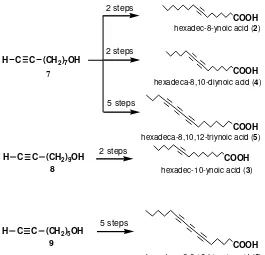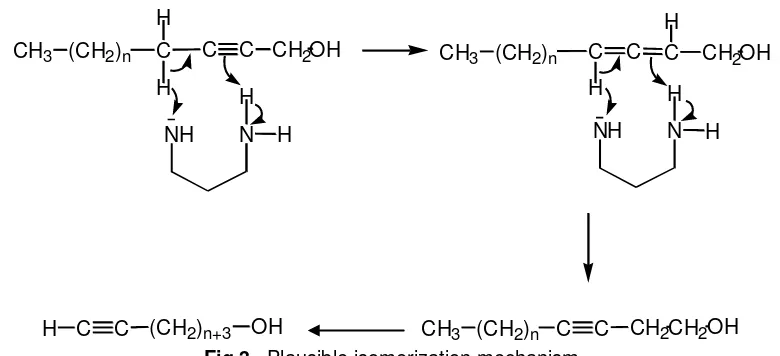Indo. J. Chem., 2007, 7 (3), 320-323
Hendig Winarno
320
* Email address : [email protected]
RAPID ISOMERIZATION OF ALKYNOL
BY POTASSIUM AMINOPROPYLAMIDE REAGENT
Hendig Winarno
*Center for the Application of Isotopes and Radiation Technology, BATAN, Jakarta Jl. Cinere Pasar Jumat, Lebak Bulus, Jakarta 12440
Received 18 July 2007; Accepted 20 August 2007
ABSTRACT
Terminal alkynol (-alkynol) is an intermediate compound in synthesis of a potent anticancer agent, namely C-16 alkynic fatty acid. For synthesis of this intermediate compound, it is needed to synthesize the appropriate internal alkynol, namely 2-nonyn-1-ol (10), 2-undecyn-1-ol (11), and 2-heptyn-1-ol (12), subsequently to convert these internal alkynol into terminal alkynol, namely 8-nonyn-1-ol (7), 10-undecyn-1-ol (8), and 6-heptyn-1-ol (9), an isomerization reaction was needed. Based on the method which developed by ABRAMS by using potassium 3-aminopropylamide (KAPA) reagent, the isomerization reaction could be done within 5 minutes in 93-94% yield.
Keywords : Isomerization, KAPA reagent, alkynol.
INTRODUCTION
Scurrula atropurpurea (BL.) DANS. ( Lorantah-ceae) is a parasitic plant onto tea plant (Thea sinensis L.) as a host, which so called “benalu teh” in Indonesian. Some of the Loranthaceous plants have been recognized widely as traditional medicine in the world. In Japan, Viscum album L. var. lutecens MAKINO has been used as folk medicine for curing lumbago, after childbirth, etc. [1]. Meanwhile, in Korea, China and Europe Viscum album L. has been used for cancer treatment since along ago [2]. Recently, those effect on anticancer agent have become a focus, nevertheless from the research and clinical results, the effectiveness as anticancer is still doubted.
In 2003, the octadeca-8,10,12-triynoic acid (1) (Fig 1) have been isolated from the 70% aqueous acetone extract of whole plant of Scurrula atropurpurea (BL.) DANS. This compound exhibits a potent inhibitory effect on cancer cell invasion (IC50 = 2,7 g/mL) through a rat mesothelium monolayer by using MM1 cancer cell lines isolated from rat ascites hepatoma AH 130 cells [3]. It is suggested that octadeca-8,10,12-triynoic acid (1) may be the active principal of the parasitic plant Scurrula atropurpurea which has been used for treatment of cancer in Java island.
Octadeca-8,10,12-triynoic acid has 18 of carbon atoms and three triple bonds at position of C-8, 10, and 12. It is supposed that the length of the carbon atom, unsaturation degree, and the position of triple bond have the important role toward inhibitory activity, so, based on those facts, it might be interested to examine the inhibitory activity of difference carbon number of alkynic fatty acids, namely hexadec-8-ynoic acid (2), hexadec-10-ynoic acid (3), hexadeca-8,10-diynoic acid (4), hexadeca-6,8,10-triynoic acid (5), and hexadeca-8,10,12-triynoic acid (6) [4]. The compound 5 and 6 were
new compounds. These five C-16 alkynic fatty acid analogues were synthesized through coupling reaction of intermediate compounds 8-nonyn-1-ol (7), 10-undecyn-1-ol (8), and 6-heptyn-1-ol (9) with the suitable reagents via some reaction steps as described in Fig 2.
Brown et al. have used potassium 3-aminopropylamide (KAPA) as a superbase for prototropic processes [5]. He was successfull in the use of KAPA reagent for converting the 2-hexyne to 1-hexyne and limonene to p-cymene. He prepared KAPA from potassium hydride and 3-aminopropylamide (APA). Okada et al. also used the same reagent for preparing 6-heptyn-1-ol (9) from isomerization of 2-heptyn-1-ol (12) [6]. Meanwhile Spence et al. have been examined the potassium N-methylbutylamide (KMBA), potassium diisopropylamide (KDA), and KAPA for studying isomerization of some allenes [7].
In this paper, intermediate compounds 8-nonyn-1-ol (7), 10-undecyn-1-ol (8), and 6-heptyn-1-ol (9) were synthesized from the internal alkyn-1-ol, namely: 2-nonyn-1-ol (10), 2-undecyn-1-ol (11), and 2-heptyn-1-ol (12) which converted to terminal () position based on the isomerization reaction by using KAPA reagent. The internal 2-alkyn-1-ol (10, 11, 12) were prepared from propargyl alcohol (13) with suitable bromoalkane (14,
15, 16) acording to Zeni et al. [8]. Different to Brown [6] and Spence [7], the KAPA reagent in this study was simply prepared by using Abrams’s method [9].
Indo. J. Chem., 2007, 7 (3), 320-323
Hendig Winarno
321
COOH
COOH
COOH hexadec-8-ynoic acid (2)
hexadeca-8,10-diynoic acid (4)
hexadeca-8,10,12-triynoic acid (5)
H C C (CH2)7OH
7
2 steps
5 steps 2 steps
H C C (CH2)9OH COOH
H C C (CH2)5OH
COOH
8 hexadec-10-ynoic acid (3)
9
hexadeca-6,8,10-triynoic acid (6) 2 steps
5 steps
Fig 2. The synthesis scheme of C-16 alkynic fatty acids from alkynol (7), (8), and (9)
EXPERIMENTAL SECTION
General information
HR-EI-MS were taken on a JMS 102A mass spectrometer, whereas GC-MS/DIP-MS was taken on a Shimadzu QP-5000. IR spectra were run on a Shimadzu FT-IR 8500 spectrophotometer and UV spectra on a Hitachi U-3500 spectrophotometer. 1H and 13C NMR spectra were recorded on a JEOL JNM-AL 300, 300 MHz and 75 MHz, respectively. CDCl3 was used as NMR solvent and chemical shifts are given in scale (ppm) relative to tetramethylsilane (= 0 ppm) as internal standard. HPLC was done on a 3 dimension Hitachi L-7400 series, 3 dimension Tosoh PD-8020 and a Shimadzu LC-6A equipped with photo diode-array detector and refractive index detector. Fast column chromatography was carried out on silica gel 60 (70–230 mesh ASTM, Merck). Thin-layer chromatography on silica gel 60 F254 plate (Merck) was used for monitoring of reaction kinetic and hecking the fraction collected from column chromatography. The spots on TLC were detected by short and long wavelength ultraviolet light and visualized by spraying the plates with 1% Ce(SO4)2 in 10% aqueous sulfuric acid followed by heating. All the glass apparatus and syringes were dried in oven at a temperature of 120 oC for 30 min prior to use. All of these reactions were performed under argon atmosphere. Prior to use, 3-aminopropylamide (APA) was distilled with BaO and stored at molecular sieves 4A.
Preparation of KAPA reagent
To a round-bottom flask contained distilled 3-aminopropylamide (APA) was added granular lithium with the ratio of APA : Li = 10 : 1 in argon atmosphere. The mixture was heated at temperature of 70 oC and stirred for about 1.5 hour untill the blue color appeared. This blue color would disappeared within 30 min and a milky-white suspension was formed. After cooling to room temperature, to the suspension was added potassium t-butokside (t-BuOK) with the molar ratio of Li : t-BuOK = 5 : 4, while the stirring was continued untill the yelowish precipitate was formed within 15 min. This suspension so called KAPA reagent (kalium
3-aminopropylamide). Subsequently, to this suspension was added the samples 10, 11, or 12.
Preparation of 2-alkyn-1-ol (10), (11), (12)
2-Nonyn-1-ol (10)
To a solution of propargyl alcohol 13 (1.96 g, 35.0 mmol) in tetrahydrofuran (THF, 32 mL) and hexamethylphosphoric triamide (HMPA, 16.0 mL) was added dropwise n-BuLi (43.8 mL, 70.0 mmol) at –78 C and the reaction mixture was allowed to reach –30 C. To the reaction mixture was added 1-bromohexane 14 (5.78 g, 35.0 mmol) at –30 C and the whole was stirred at room temperature for 12 hr. The reaction mixture was treated with aqueous saturated NH4Cl and the whole mixture was extracted with Et2O. The Et2O extract was washed with brine and dried over MgSO4. Removal of the solvent gave a product of 6.8 g. Purification of the product by silica gel column chromatography (SiO2 = 250 g, n-hexane:EtOAc = 5:1) afforded 2-nonyn-1-ol 10 (4.17 g, 29.8 mmol, 85% yield).
2-Undecyn-1-ol (11)
To solution 13 (840 g, 15.0 mmol) in THF (13 mL) and HMPA (6.5 mL) was added dropwise n-BuLi (18.8 mL, 30.0 mmol) and then 1-bromooctane 15 (3.18 g, 16.5 mmol) in the same condition as preparation of 2-nonyn-1-ol (10). After treatment as described in the preparation of 2-nonyn-1-ol (10) and removal of the solvent, a 3.0 g of product was obtained. Purification of the product by silica gel column chromatography (SiO2 = 100 g, n-hexane:EtOAc = 5:1) afforded 2-undecyn-1-ol 11 (2.12 g, 12.6 mmol, 84% yield).
2-Heptyn-1-ol (12)
Indo. J. Chem., 2007, 7 (3), 320-323
Hendig Winarno
322
of the product by silica gel column chromatography (SiO2 = 60 g, hexane:EtOAc = 8:1) afforded 2-heptyn-1-ol 11 (1.18 g, 10.5 mmol, 84% yield).
Preparation of-alkyn-1-ol (7), (8), and (9)
8-Nonyn-1-ol (7)
To the KAPA reagent [made from 1,3-diaminopropane (100 mL), Li (1.40 g, 200 mmol) and potassium t-butoxide (13.4 g, 120 mmol)] was added 2-nonyn-1-ol 10 (4.17 g) and the whole mixture was stirred at room temperature for 30 min. The mixture was poured into ice-water and the whole was extracted with CHCl3. Colorless oil. IR (film) cm-1: 3600-3100 (br), 3304, 2118. 1 stirred at room temperature for 30 min. The mixture was poured into ice-water and the whole was extracted with CHCl3. The CHCl3 extract was washed with brine and dried over MgSO4. Removal of the solvent gave a product of 2.5 g. Purification of the product by silica gel column chromatography (SiO2 = 100 g, hexane:EtOAc = 7:2) afforded 10-undecyn-1-ol 8 (1.97 g, 11.7 mmol, 93% yield).
The physical and chemical properties of 8: Colorless oil. IR (film) cm-1: 3600-3100 (br), 3305, 2118.
Indo. J. Chem., 2007, 7 (3), 320-323
Hendig Winarno
323
C C C CH2
(CH2)n
CH3 OH
N
NH H
H H
H
C C C CH2OH
N
NH H
H H
H
C C CH2CH2OH
C C (CH2)n+3
H OH
(CH2)n
CH3
(CH2)n
CH3
Fig 3. Plausible isomerization mechanism
Subsequently, the triple bond at internal position (beta, ) of 10, 11, and 12 were shifted to terminal position (omega, ) by using KAPA reagent. These isomerization reaction was very fast, the triple bond shifted whitin 10 min. When the monitoring of reaction kinetic was done by TLC after 10 min reaction, the starting materials (10, 11, or 12) were not found in TLC spot, in contrast, the new spot at different Rf appeared. This fact suggested that the reaction have already finished and the new product, namely the – alkynol 7, 8, and 9 have been formed. After purification by silica gel column chromatography, the high yield product (93-94%) was obtained. The previous isomerization using KAPA prepared from potassium hydride and APA was obtained in 64% [6] and 85% [8]. This isomerization reaction using KAPA was popularized by Abrams [9] and Brown [10]. The isomerization mechanism was not yet been discovered, butAbramset al. proposed the plausible mechanism as described in Fig 3 [11]. By the same method, the shift of triple bond could be done and this method is very versatile.
CONCLUSION
The isomerization reaction of internal alkynol to terminal alkynol was easily done by using KAPA (potassium aminopropylamine) reagent. The reaction occurred within 10 min in 93-94% yield.
REFFERENCES
1. Mizuno, M. and Maeda, K.,1997, New Japanese Regulation, Tokyo, p. 518-519
2. Cheng, R. K.-Y. Z., 1997, Drugs of the Future, 22, 519.
3. Akedo, H., Shinkai, K., Mukai, M., Mori, Y., Tateishi, R., Tanaka, K., Yamamoto, R., and Morishita, T.,1986, Cancer Res., 46, 2416.
4. Ohashi, K., Winarno, H., Mukai, M., Inoue, M., Prana, S. M., Simanjuntak, P., and Shibuya, H., 2003, Chem. Pharm. Bull., 51, 343.
5. Brown, H. C., Jadhav, P. K., and Desai, M. C., 1982, J. Org. Chem., 47, 4583.
6. Okada, S., Doi, T., Mito, A., Hayamizu, K., Ticktin, A., Matsuda, H., Kikuchi, N., Masaki, A., Minami, N., Hass, K.-H., and Nakanishi, H., 1994, Nonlinear Optics, 8, 121-132.
7. Spence, J. D., Wyatt, J. K., Bender, D. M., Moss, D. K., and Nantz, M. H., 1996, J. Org. Chem., 61, 4014.
8. Zeni, G., Panatieri, R. B., Lissner, E., Menezes, P. H., Braga, A. L., and Stefani, H. A., 2001, Org. Lett.,3, 819.
9. Abrams, S. R, 1984, Can. J. Chem., 62, 1333. 10. Brown, C. A., 1975, J.C.S. Chem. Comm., 222. 11. Abrams S. R. and Shaw, A. C., 1987, J. Org.


